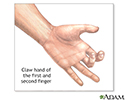Claw hand
Ulnar nerve palsy - claw hand; Ulnar nerve dysfunction - claw hand; Ulnar claw
Claw hand is a condition that causes curved or bent fingers. This makes the hand appear like the claw of an animal.
Considerations
Someone can be born with claw hand (congenital), or they can develop it because of certain disorders, such as a nerve injury.
Causes
Causes may include:
- Congenital abnormality
- Genetic diseases, such as from Charcot-Marie-Tooth disease
- Nerve damage in the arm
- Scarring after a severe burn of the hand or forearm
- Rare infections, such as leprosy
When to Contact a Medical Professional
If the condition is congenital, it is usually diagnosed at birth. If you notice claw hand developing, contact your health care provider.
What to Expect at Your Office Visit
Your provider will examine you and look closely at your hands and feet. You will be asked questions about your medical history and symptoms.
The following tests may be done to check for nerve damage:
- Electromyography (EMG) to check the health of the muscles and the nerves that control the muscles
- Nerve conduction studies to check how fast electrical signals move through a nerve
Treatment depends on the cause. It may include:
- Splinting
- Surgery to fix problems that may be contributing to the claw hand, such as nerve or tendon problems, joint contractures, or scar tissue
- Tendon transfer (graft) to allow movement of the hand and wrist
- Hand therapy to straighten the fingers
References
Bauer B, Chaise F. Correction of ulnar claw hand and Wartenberg's sign. Hand Surg Rehabil. 2022;41S:S118-S127. PMID: 34311132 pubmed.ncbi.nlm.nih.gov/34311132/.
Davis TRC. Tendon transfers for median, radial, and ulnar nerve palsy. In: Wolfe SW, Pederson WC, Kozin SH, Cohen MS. Green's Operative Hand Surgery. 8th ed. Philadelphia, PA: Elsevier; 2022:chap 31.
Feldscher SB. Therapy management of tendon transfers. In: Skirven TM, Osterman AL, Fedorczyk JM, Amadio PC, Feldscher SB, Shin EK, eds. Rehabilitation of the Hand and Upper Extremity. 7th ed. Philadelphia, PA: Elsevier; 2021:chap 44.
Review Date: 8/27/2024









